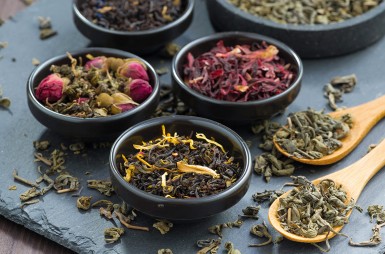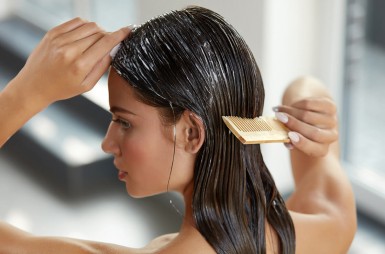How to successfully dye your hair at home using natural products
Written by Marion, Aesthetician/Cosmetician | published on | updated on 17/04/2024

Do you want to dye your hair yourself at home using natural dyes? Less toxic for the hair fibre, vegetable dyes are easy to apply at home giving results as good as a professional treatment. Here are our suggestions for successful dyeing and how to maintain it using specialist hair care products.
More about natural dyes
What are they made of?
Vegetable dyes are mostly made up of natural ingredients. These are vegetable pigments which colour the hair, usually obtained from powdered plants or roots such as indigo or safflower. They are mixed with other ingredients to fix the colour on the hair.
How do they differ from classic hair dye?
In contrast to classic hair dyes, natural hair dyes do not contain chemical or oxidising colouring products. The ingredients do not contain either ammonia, peroxide, parabens or silicones. These dyes look after the hair fibre and prevent the hair becoming dry or wiry. They also make the hair shinier and full of sunlight reflections. Coverage is sometimes less “strong” than with classic dyes even if it does provide perfect root coverage. 100% natural hair dyes do fade gradually over time, after several months in contrast with permanent chemical dyes.
Focus on henna
Have you heard about henna? This is a natural powder obtained from the leaves of a shrub which colours hair long term. There are orange, yellow and auburn tints. Henna is known for its thickening and strengthening properties
Are all shades available?
The shades found in vegetable dyes reflect the colours found in the plants from which they come: black, mahogany, auburn, gold, but including rust or red reflections as well. It is not possible to colour hair blue or pink using natural dyes. However, the range of shades is wide, going from strawberry blond to very dark brown. All the same, it is not possible to go from brown to a platinum blond. To achieve this you would need to use hair colour removers which contain oxidation products (such as oxygenated water) to strip the hair entirely. Nevertheless, natural dyes will cover white hair. As with classic hair dyes, the final shade will depend upon the natural shade of your hair.
How to successfully dye your hair at home step by step
Prepare hair and materials
Before using a vegetable dye, the application of a green clay mask to the hair will detoxify and clean it of possible residues of old chemical dyes or hair care products. Next, protect the skin by covering shoulders and neck. Ideally, ask someone else to apply the dye, wearing protective gloves. Have a comb, preferably wooden, to hand. Then prepare the vegetable dye according to the instructions on the packet: usually mixing a colouring powder with a fixative.
Applying the dye
Next apply the dye. If you have short hair, this can be done in one stage: apply the product from one side of the head to the other and finish by combing through to spread out the product. If you have long hair it is best to proceed in sections. Start with the hair underneath, pinning the rest of the hair to the top of head. Apply the colour on to the short lengths, combing them to spread the dye. Take another section from above and repeat the process. The colour can be applied to small sections to give highlights or a streaked effect Then leave the dye for the length of time indicated in the instructions.
Rinse and wash the hair
Now it is time to rinse. Once again, follow the instructions on the box. After removing most of the product, it is best to rinse the hair and then wash it twice with shampoo. For this process, use a gentle shampoo which you could use with conditioner or a mask, especially if you have long hair. Some dyes provide a nourishing hair treatment to apply at this stage. Allow the hair to dry naturally.
Looking after coloured hair
Daily hair washing
Ideally hair should be washed using a gentle, natural shampoo which does not contain surfactants to create foaming. You could also look at the ranges of special shine and bright shampoos especially created for coloured hair. Bear in mind that coloured hair is often more fragile and it is a good idea to use masks and conditioning treatments regularly such as hair serums if you have curly or damaged hair. Even with coloured hair therefore, continue to nourish it with a complete hair routine.
Maintaining the length of the colour
It is important to take care of your hair using tailored products to maintain your colour. For this, look at the range of hair products for maintenance of coloured hair. If you have chosen a dark hair colour, avoid too much exposure to sunlight which tends to lighten the hair colour. Unlike chemical hair dyes, there is no particular contra-indication to sea or swimming pool water when using vegetable dyes. Since these do not contain peroxide or synthetic dyes, the colour will not turn green when in contact with chlorinated swimming pool water, for example.
Ingredients, application, maintenance: now you know enough about vegetable hair dyes to allow you to colour your hair in a softer manner, giving it lovely natural reflections.
The three key points to remember about natural dyes :
- Natural hair dyes look after the hair better;
- They can be applied to the full head or as highlights, just like classic dyes;
- It is best to use specialist ranges of haircare for coloured hair to maintain the colour.























